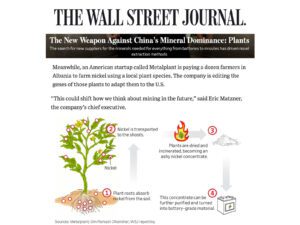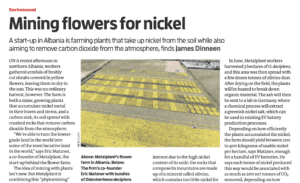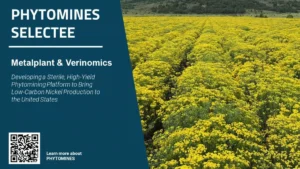Hyperweathering: Enhanced Rock Weathering for Climate Change Mitigation Meets Phytomining Technology
Hyperweathering: Forging a Carbon-Negative Future with Critical Minerals and Enhanced Rock Weathering Introduction: Addressing Intertwined Global Crises Humanity stands at a critical juncture, facing the dual and interconnected crises of accelerating climate change and escalating resource scarcity. The scientific consensus, powerfully articulated by the Intergovernmental Panel on Climate Change (IPCC) and corroborated by the latest data from the World Meteorological Organization and Copernicus, confirms that 2024 was the warmest year on record, with the global average temperature exceeding 1.5°C above pre-industrial levels for the calendar year. Atmospheric carbon dioxide concentrations continue their relentless climb, reaching approximately 422.1 ppm in 2024. The Global Carbon Budget 2024 report underscores the urgency, revealing that global fossil fuel CO2 emissions hit a new record in 2024, leaving a perilously small carbon budget – estimated at roughly six years at current rates for a 50% chance of limiting warming to 1.5°C. This stark reality necessitates a paradigm shift in our approach. The IPCC’s assessments make it unequivocally clear: deep emissions reductions alone are insufficient. We must actively develop and deploy scalable technologies for Carbon Dioxide Removal (CDR) to draw down legacy emissions and address hard-to-abate sectors. Concurrently, the vital transition to a green energy economy—our primary weapon in decarbonization—hinges on an unprecedented supply of critical minerals. The International Energy Agency (IEA) projects that demand for metals like nickel, lithium, and cobalt could skyrocket by up to 1,900% for nickel and 4,200% for lithium by 2040, as these are foundational to electric vehicles, battery storage, and renewable energy infrastructure. Traditionally, these monumental challenges have been tackled in silos. Carbon removal strategies pursued avenues like direct air capture or afforestation, while critical minerals were sourced via conventional mining—a sector grappling with significant environmental and social footprints. Metalplant is charting a new, integrated course. We have pioneered “Hyperweathering,” a breakthrough approach that synergistically combines Enhanced Rock Weathering (ERW) with phytomining, not only to sequester atmospheric CO₂ but also to sustainably produce essential critical minerals with a net-carbon-negative footprint. Our flagship product, NegativeNickel™, embodies this vision. This article delves into the robust scientific underpinnings of hyperweathering. It explores its profound potential for climate change mitigation, its positioning as a responsible geoengineering technique, and its pivotal role in fueling the green energy transition through the sustainable provision of critical minerals. Metalplant’s innovation represents a transformative step in how we conceive resource utilization and carbon stewardship, demonstrating that ecological restoration and industrial necessity can be mutually reinforcing. The Science of Enhanced Rock Weathering: Accelerating Nature’s Carbon Sink Natural Carbon Sequestration: Earth’s Slow Geochemical ThermostatTo appreciate the innovation of Enhanced Rock Weathering, one must first understand Earth’s natural long-term carbon cycle. The geological weathering of silicate rocks is a primary mechanism by which the planet has regulated atmospheric CO₂ over eons. When rainwater, slightly acidic from dissolved atmospheric CO₂, interacts with silicate minerals, a series of chemical reactions ensues. These reactions convert gaseous CO₂ into stable bicarbonate ions (HCO₃⁻). These ions are transported by rivers to the oceans, where marine organisms utilize them to form calcium carbonate shells and skeletons. Upon their demise, these organisms sink, eventually forming limestone and other carbonate rocks, effectively sequestering carbon for geological timescales – hundreds of thousands to millions of years. This natural process, while profoundly important, operates on timescales far too slow to counteract the current anthropogenic surge in CO₂ emissions. Globally, natural silicate weathering is estimated to remove only about 0.3 gigatons of CO₂ annually, a small fraction of the over 40 gigatons emitted by human activities each year. Enhanced Rock Weathering seeks to dramatically accelerate this natural carbon sink to achieve climate-relevant CO₂ removal within human timescales. As the Department of Energy’s Carbon Negative Shot initiative highlights, developing cost-effective and scalable CDR solutions like ERW is paramount. Metalplant’s Hyperweathering: A Synergistic Leap ForwardMetalplant’s proprietary hyperweathering process significantly advances ERW technology. Conventional ERW typically involves spreading crushed silicate rocks, such as basalt or olivine, onto agricultural lands, relying on natural processes for weathering and carbon sequestration. Hyperweathering, however, employs an actively managed, multi-faceted strategy to boost both the rate and overall efficiency of CO₂ removal, integrated with phytomining. Our process meticulously begins with the sourcing and preparation of olivine, a magnesium iron silicate mineral ((Mg,Fe)₂SiO₄). Olivine is chosen for its relatively rapid weathering rate compared to other silicate minerals and its abundant global availability. Metalplant has secured exclusive access to a multi-billion tonne, high-purity olivine deposit (approximately 80% forsterite olivine, 0.33-0.343% nickel) adjacent to our Albanian operations, supplied at a very low cost by a co-founder. This olivine undergoes proprietary grinding processes to achieve an optimal particle size (sub-100 micron) that maximizes reactive surface area while managing potential dust. The process also includes mechanical gravimetric operations to remove loose chromite, at a net cost of approximately $4/tonne of olivine after accounting for potential chromium byproduct sales. The processed olivine is then applied to carefully selected nickel-bearing serpentine soils – the native habitat of the hyperaccumulator plants we utilize. Metalplant’s innovation lies in moving the farm to the rocks, operating on ultramafic soils that are themselves derived from these minerals. We employ several interventions to accelerate weathering: Optimized Application & Soil Interaction: We target substantially higher application rates (e.g., 100 tonnes/hectare) than some conventional ERW proposals. This is driven by the need to replenish nickel extracted by phytomining, but also contributes to potentially the highest density ERW-based carbon removal per land unit per year. The olivine is mixed into the soil where elevated CO₂ levels from root respiration and microbial activity, along with direct water exposure, accelerate dissolution. Biocatalyst and Chelator Research: While the draft mentions partnerships with Sheffield University for microbial communities and the Leverhulme Centre for chelator-enhanced weathering, Metalplant’s provided background files also mention exploring iron chelators as a biotechnology to accelerate weathering, referencing a study showing a 2.5x increase in basalt weathering, suggesting even greater potential for pure olivine. Hyperaccumulator Plant Integration (Phytomining): This is the cornerstone of Metalplant’s unique hyperweathering system. We utilize specific nickel hyperaccumulator plant species, particularly a



